Article and all photos by Joe Mock, BaseballParks.com
All rights reserved
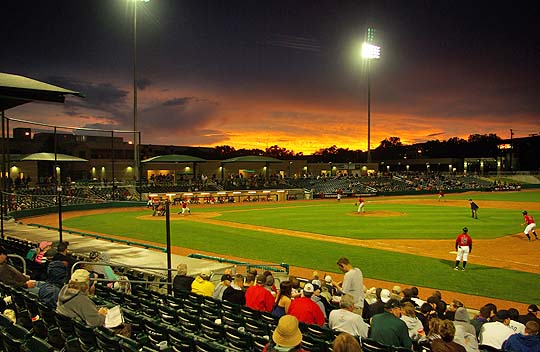 |
As I entered the radio booth to be interviewed in the 5th inning of the Billings Mustangs’ first game at Dehler Park, I heard a fan say to his row-mate just outside the booth’s window: “Man, what a ballpark!”
| Ballpark Stats |
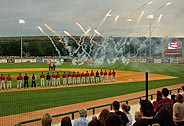 |
| Team: The Billings Mustangs of the Pioneer Baseball League |
| First game: July 1, 2008, a 9-7 victory over Great Falls |
| Capacity: 3,500 |
| Architect: HNTB and CTA |
| Price: $12.5 million |
| Home dugout: Third base side |
| Field points: Northeast |
| Playing surface: Mixture of Bluegrass and Bermuda |
| Betcha didn’t know: The bleachers down the first-base line were salvaged from Cobb Field |
Such was the sentiment of the wide-eyed Montanans who crowded into their brand-new park on the rainy night of July 1. Gone was 60-year-old Cobb Field, the aging home of American Legion and Pioneer League baseball in Billings. In its place was Dehler (pronounced “DEE-ler”) Park, built just two hundred feet or so to the west of where Cobb once stood.
So let’s get one matter out of the way: this is not a refurbished park, or a rebuilt park. This is a completely new facility, one whose footprint overlaps somewhat where Cobb Field had stood through the 2007 season, but it was not constructed in exactly the same place. In fact, the attractive main entry way is right next to the intersection of 27th Street, the main route through downtown, and 9th Avenue, instead of having a pool and youth field between the busy thoroughfare and the park.
The arrival of the ballpark was not without turmoil. No one argued that Cobb Field needed to be replaced, but where to come up with the money to do it was the big issue. In fact, for those of us who don’t live in that part of the world, it’s hard for us to understand the political process that ultimately yields the funding for a new sports facility. There is no state commission with funds earmarked for ballpark construction, nor are the local cities and counties authorized to simply decree that public funds are to be utilized for projects like this.
No, in Idaho and Montana, obtaining the funds for a ballpark is very complicated. Truly, this area is God’s Country, and the folks there feel that if God didn’t put it in the Bible that tax dollars are to be used for a baseball stadium, then those funds are not going to be allocated easily.
Indeed, an ambitious ballot initiative was put before the voters in June 2004. Its $17-million pricetag included money for a new city aquatic center as well as the ballpark. Sports-architecture heavyweights HOK in fact designed a complex with a new swimming pool and new ballpark for the block that contained Cobb Field, and the angle of including the pool was supposed to ensure that the bonds would be approved.
Well, the measure was voted down. Undaunted, the team spearheaded a new, simpler ballot initiative in November of 2006. The no-swimming-pool design was prepared by national architecture firm HNTB and local firm CTA. The second time was the charm, as the locals approved the $12.5 million bond issue and the race to replace Cobb Field had begun.
When you visit this part of the country and study the way the pro baseball parks are financed, it really is a different world. Not only is it as ruggedly scenic as any area within the U.S., it’s also a bigger struggle than anywhere else to come up with the money to construct or renovate the ballparks. As you look at what two other Pioneer League teams had to go through to get to where they are today with their parks, you’ll understand what I mean. In Idaho Falls, the team worked for years to be able to rebuild aging, sub-standard McDermott Field, and in 2007, Melaleuca Field finally made its debut. The team in Lethbridge, Alberta moved to Missoula ten years ago with the expectation of having a shiny new river-front park in a year. Well, that one year turned into five at a barely passable American Legion field on the western edge of town, and even when they did move into the new park in 2004, it was certainly not a finished product. In fact, it was 2007 before beautiful Ogren Park at Allegiance Field was deemed “complete” — and to this day, there are still fund-raising efforts for the “Play Ball Missoula” campaign that was behind the ballpark construction..
Truly, you half-expect to see bake sales taking place on the concourses to raise money to pay for ballparks in Montana and Idaho.
So give credit to the Billings Mustangs for raising over $2 million toward the contstruction cost themselves (including a $1 million donation from local businessman Jon Dehler in exchange for the naming rights to the park) and continuing to work for a new facility. Their efforts were truly impressive.
So let’s take a look at how Dehler Park rates in the areas of site selection, exterior, interior design and the all-important game-day experience.
The Setting
The new ballpark is roughly where the old ballpark was. But is that the end of the story?
No. By positioning the new structure a little more to the west — while still in the same city block — the architects were able to create a much nicer effect. Instead of being set well back from the street, like was the case with now-demolished Cobb Field (below left), the main entryway is now right by the main thoroughfare. This repositioning also allowed the field to be oriented a little a little more toward the west, which gives fans an even better view of the city’s famous “rimrocks” a few miles beyond the outfield fences.
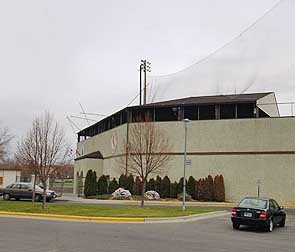 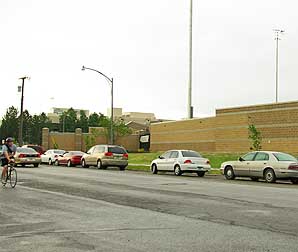 |
In a city the size of Billings, I’m not sure that it’s incredibly relevant what surrounds the ballpark. For the record, though, Dehler Park sits between a residential area to the east and a hospital across 27th Street. Just to the south along 27th is the main business district of the town, with fast-food restaurants, gas stations and a hotel. Parking isn’t abundant adjacent to the park, so a lot of fans park along the streets in the neighborhood that surrounds the stadium.
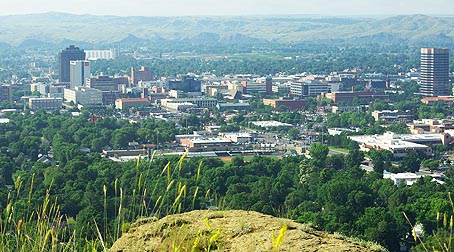 |
Now what about those “rimrocks?” As you probably know, Montana has a lot of buttes. These hills are marked by erosion on all sides, while the plateaus on top are essentially a layer of extra-hard rock, such as sandstone. While the elevated area on the northern edge of Billings probably isn’t technically a butte, its rim of exposed rocks is a beautiful sight … one which baseball fans here have enjoyed looking at from their seats for generations.
And if you make the short drive up the hill to look down on the city from those rocks, you’ll find a gorgeous view … a view that not only includes the new ballpark (in the very center of the shot above), but also an incredibly expansive view of the Yellowstone River Valley.
The Exterior
Well, it’s pretty much official now. No longer is the ubiquitous red brick the exterior of choice in new ballparks. Now light-colored block is all the rage. Arvest Ballpark in Springdale, Arkansas made gorgeous use of natural stone. The other new Minor League park for 2008, Coca-Cola Park in Allentown, has some brick elements, but the exterior is largely neutral-colored block.
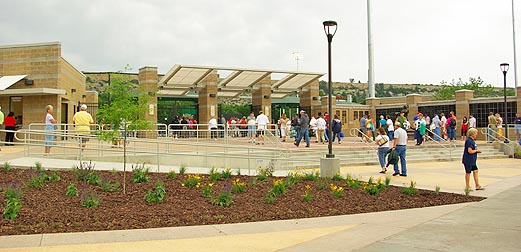 |
Dehler Park has also shunned the brick look, opting instead for a beautiful arrangement of block. There are rows of horizontal gray blocks to break up the alternating sections of two different shades of neutral-shaded blocks. It’s a great look, and you can see it in the photo of the ticket windows below.
The main entryway (shown above) is done is the same beautiful, understated style. There is a small plaza which is a few steps up from the street level (which also helps elevate the main concourse inside, which is important because the field is well below street level). That plaza has enough room for groups to gather before going in. There are also sloping panels over the gates themselves. These panels, as architects like to say, invite the fans to come into the park.
 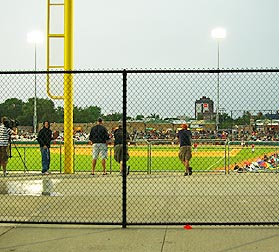 |
There are also entryways down both lines, although they aren’t utilized nearly as much as the one behind home plate. Even these are adorned with lovely stone columns that pick up the same pattern as the rest of the exterior.
It’s interesting that the fencing that separates the outfield concourse from the street (above right) allows fans who haven’t purchased tickets to see the field clearly. This has also been done at several other recent parks, notably Dickey-Stephens Park in Arkansas and Fifth-Third Field in Dayton.
The Design
One of my favorite aspects of Dehler Park is that it isn’t over-done. You would never describe it as ostentatious or overbuilt.
On Opening Night, I had the pleasure of meeting David Juranek of the Sports Architecture Department at HNTB, that firm that designed the ballpark. “When the people voted to fund this (park),” he explained, “we were essentially told ‘We don’t want anything too elaborate. We want something that matches the purity of the sport of baseball.’ So that guided how we designed the park.”
And, indeed, the focus at this ballpark is on the playing field, as the open concourse allows you to see the action from everywhere behind the seats except directly behind home plate, where you’ll find the free-standing building containing the press box.
Even though the park isn’t ostentatious, there is one feature that is a wonderful, special touch: the canopies. With no upper deck or any other structure from which to attach an overhang, the fans would have no protection from sun or rain without these welcome coverings. In a way, these are the most distinctive characteristics in a park that is somewhat devoid of standout features … and the lack of showy elements is just the way the folks in Billings wanted it!
 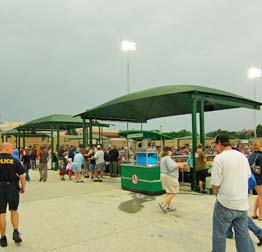 |
It’s interesting that the ballpark that most reminds me of Dehler Park is Appalachian Power Park in Charleston, WV. I thought this even before I realized that it was also designed by HNTB. While the “App” is a larger, more ambitious project, it also lacks an upper deck and has only a free-standing building for the press behind home plate. And its most noteworthy feature? Its canopies.
And with no upper deck, there’s no place for luxury suites at Dehler Park — not that the people of Billings were clamoring for them. Juranek told me that, “we were told that suites are elitist, and that they didn’t want to do anything that would separate the fans into different classes, so we didn’t put any suites in.” This is in direct contrast with another Pioneer League park, Melaleuca Field in Idaho Falls. It was completely rebuilt in time for the 2007 season, and when fans entered the reborn stadium, they found that it had eight luxury suites.
The concourses at Dehler Park really do deserve special mention. Not only are they extra wide (below left) — which is greatly appreciated at games that are sold out, like Opening Night — they ring the entire field (gee, just like in West Virginia). It is really rare that a park at this level has a so-called 360-degree concourse. In fact, I believe Billings has the only one in the Pioneer League. The shot on the right below shows the view from this concourse in right-center field.
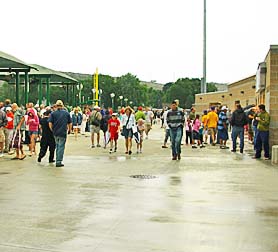 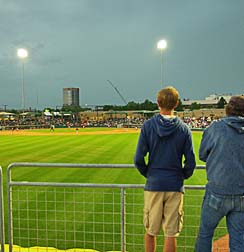 |